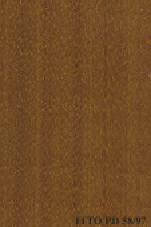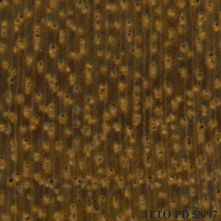
DIBéTOU (Lovoa trichilioides)
Trade Name
Dibétou
Scientific Name
Lovoa trichilioides Harms
Family
MELIACEAE
Common Names
Wnaimei (Sierra Leone); Apopo (Nigeria); Noyer d'Afrique (France); Noyer du Gabon (France); Noyer d` Afrique (France); Congowood (United States of America); Tigerwood (United States of America); Tigerwood (United Kingdom); African walnut (United Kingdom); Embero (Equatorial Guinea); Nivero (Equatorial Guinea); Bombulu (Zaire); Lifaki-muindu (Zaire); Eyan (Gabon); Bibolo (Cameroon); Anamenila (Nigeria); Sida (Nigeria); Apolo (Nigeria); Mpengwa (Ghana); Dubini-biri (Ghana); Dibetou (Côte d`Ivoire)
Scientific Name Synonyms
Lovoa pynaertii De Wild.; Lovoa klaineana Pierre ex Sprague
Description Of The Tree
Botanical Description
The tree reaches a height of 50 m, with trunk diameters of 100 cm. The bole is usually straight, clear and cylindrical to 20 to 30 m in length, with short buttresses.
Natural Habitat
Lovoa trichilioides occurs in evergreen and deciduous forest, generally in moist sites. Regeneration occurs only in canopy gaps. National conservation status in Cote d`Ivoire V, Liberia E. It is known or inferred that the harvesting of specimens from the
Natural Distribution
West Africa, from Sierra Leone to Gabon.
Wood Identification
Anatomic Description Of Wood
Wood diffuse porous. Occasionally vessels exclusively solitary (over 90%). Tangential diameter of vessel lumina 150 to 200 micras (medium). Brown-colored deposits in heartwood vessels. Non-vestured pits. Vessels per mm2 6 to 10 (medium). Simple perforation plat Apotracheal axial parenchyma diffuse and/or diffuse in aggregates. Paratracheal axial parenchyma scanty and/or vasicentric. Prismatic crystals in chambered axial parenchyma cells and/or in fibers. 3 to 4 cells per parenchyma strand. 4 to 10 rays per mm (medium). Rays non-storied. Rays 1 to 4 seriate. Homogeneous rays and/or sub-homogeneous rays (all ray cells procumbent). Body ray cells procumbent with one row of upright and/or square marginal cells (Kribs-III). Occasionally septate fibers present. Fibers with simple to minutely bordered pits.
-
 Wood Macro Photo Tangential Plane
Wood Macro Photo Tangential Plane
-
 Wood Micro Photo Of Transversal Section
Wood Micro Photo Of Transversal Section
Availability
Cites Status
Unrestricted
General Wood Description
Color
The sapwood is light grey to light yellow, it has a thickness of up to 7 cm. The heartwood is grey-brown to yellow-brown, sometimes with dark veins, it is clearly demarcated. The silver figure is fine.
COLOR INDEX (1=Black, 7=Light yellow,white)
2
Grain
It has highly interlocked grain; special care is needed when drying because of frequent risks of distortion.
Texture
Texture is reported to be fine to medium.
Luster
The wood surface is described as low in luster.
Natural Durability
Slightly durable to decay. This species needs preservative treatment for uses with risks of occasional re-humidification. It is not suited for uses with risks of permanent or long-lasting humidification. Sensible to termites attack. The heartwood is resistant.
Natural durability index (1= Very high durability, 7=Vey low durability)
6
Internal Growth Stresses
Residual growth stresses are absent.
Resistance To Impregnation
Difficult to treat with only a low penetration of the preservative products.
Wood Physical Properties
Basic Density or Specific Gravity (O.D. weight/vol. green) (g/cm³)
0.49
Air-dry Density (Weight and volume at 12%MC) (g/cm³)
0.53
Total shrinkage Tangential (Saturated to 0%MC) (%)
5.8
Total shrinkage Radial (Saturated to 0%MC) (%)
3.7
Drying Defects
Ease of Drying: Drying is moderately easy; some particular care is needed. Drying Defects: Risks of distortions when interlocked grain is present. Kiln Schedules: The kiln schedule has been tested.
Recommended Dry Kiln Schedule
FR-6
Dimensional stability ratio (Total Tangential Shrinkage %/Total Radial Shrinkage %)
1.6
Wood Chemical Properties
Wood Mechanical Properties
Bending Strength (MOR),12%MC (kgf/cm²)
733
Stiffness (MOE) 12%MC (kgf/cm²)
106637
Compression parallel to fiber 12%MC (kgf/cm²)
482
Compression perpendicular to fiber 12%MC (kgf/cm²)
59
Shear strength radial 12%MC (kgf/cm²)
63
Janka hardness (side) 12%MC (kgf)
349
Janka hardness (end grain) 12%MC (kgf)
452
Workability
Sawing
It is easy to saw.
Rotary Veneer Cutting
Suitable for slicing, also suitable for peeling if treated.
Sliced Veneer
Suitable for slicing, also suitable for peeling if treated.
Blunting Effect
Slight blunting effect; ordinary tools can be used for sawing and machining.
Machining
Machining of this species is reportedly easy.
Planing
Easy; no particular problems.
Moulding
Moderately easy; tools must be cautiously sharpened.
Turning
30
Boring
Moderately easy; tools must be cautiously sharpened.
Mortising
Moderately easy; tools must be cautiously sharpened.
Nailing
No particular problem.
Gluing
Glues well if basic gluing technical rules are followed.
Sanding
Easy to perform; it gives good results.
Polishing
Can be polished without surface preparation.
Steam Bending
This species can be used for steam bending.
Response To Hand Tools
No particular problems.
REFERENCED USES
End Uses Summary
HOUSING GENERAL, beams, joists, boards, frames, steps, panelling, fittings, FURNITURE AND CABINETS, luxury furniture, cabinets, PLYWOOD AND VENEER, faces, Decorative veneer, TURNING, ornaments, turned furniture, cutlery, lasts, OTHER AND MUSICAL INSTRUMENTS, handicrafts
General Housing
- 10 - Silica in Timbers
Beams
- 11 - Prospect: The wood database
Joists
- 12 - Tropical timbers of the world. Part I-Tropical American Species
Boards
- 13 - Dry kiln schedules for commercial woods. Temperate and tropical. Section III. Latin American (Mexico, Central, and South America) Woods–Conventional Temperatures
Frames
- 16 - Woods of the World
Steps
- 17 - Tree Conservation Database
Paneling
- 18 - W3TROPICOS Missouri Botanical Garden
Fittings
- 19 - Silica in Timbers
Furniture Cabinets
- 21 - Tropical timbers of the world. Part III-Southeast Asian and Oceanian Species.
Furniture, Luxury
- 22 - Dry kiln schedules for commercial woods. Temperate and tropical. Section IV-Asian and Oceanian Woods
Cabinet
- 24 - Empire Timbers
Panels, Veneers
- 25 - Directory of Timber Trade Malaysia
Faces
- 26 - Annual Review and Assessment of the World Timber Situation 1998-ITTO
Decorative veneer
- 28 - Ministry of Agriculture, Fisheries & Forest of Fiji
Turning
- 30 - Embassy of Honduras in Japan
Ornaments
- 31 - Embassy of Colombia in Japan
Turned Articles
- 32 - Embassy of Cote d`Ivoire in Japan
Knife Handles
- 33 - Embassy of Gabon in Japan
Lasts
- 34 - Embassy of Indonesia in Japan
Handcraft
- 66 - Maderas latinoamericanas. VII. Caracteristicas anatomicas. propiedades fisicomecanicas, de secado, y tratabilidad de la madera juvenil de Cordia alliodora (Ruiz & Pav. Oken.)
Please Provide Information To View Producer Information